I'm new at using actionListener and mouselistner. I want to track the Mouse movements and connect the dots as I go. So it will be one continuous line. I am using the MouseMotionListener every time I move the mouse across the screen and get a new set of points. I am not using mousePressed or mouseReleased.
Everytime I move the mouse, I can get every point of where my mouse's position is on my JPanel to show up on my results window, but in order to draw the line between two points, I'm not sure how to decipher between each different set of points so I can have a beginning and ending set of points to use for drawing a line? I checked through here and the API and I'm stuck.
I was asked to put more code and so I gave you my code.
I am basically creating a Jpane that tracks mouse movement when the Track Mouse button or Draw Track Radio button is pressed These results will print out as (x,y) on the output screen
FYI: You can also draw circles once the Draw circles RadioButton is checked


import javax.swing.*;
import javax.swing.event.*;
import java.awt.*;
import java.awt.event.*;
import java.util.ArrayList;
public class MouseTest {
private JFrame frame;
private boolean tracking;
private boolean drawing;
private boolean connectdots;
private int xstart;
private int ystart;
private int xend;
private int y;
private int x;
private int yend;
private int borderWidth = 5;
String drawCircles = "Draw Circles";
String drawTrack = "Draw Track";
public static void main (String [] arg) {
MouseTest first = new MouseTest();
}//main
$
public MouseTest() {
tracking = false;
frame = new JFrame();
frame.setBounds(250,98,600,480);
frame.setTitle("Window number three");
Container cp = frame.getContentPane();
JButton track = new JButton("Track Mouse");
track.addActionListener(new ActionListener() {
public void actionPerformed(ActionEvent ae) {
trackMouse();
}
});
JPanel top = new JPanel();
top.add(track);
cp.add(top,BorderLayout.NORTH);
MyPanel pane = new MyPanel();
cp.add(pane,BorderLayout.CENTER);
pane.addMouseListener(new MouseAdapter() {
public void mousePressed(MouseEvent e) {
xstart = e.getX();
ystart = e.getY();
}
public void mouseReleased(MouseEvent e) {
xend = e.getX();
yend = e.getY();
if (xend < xstart) { int tmp = xstart; xstart = xend; xend = tmp; }
if (yend < ystart) { int tmp = ystart; ystart = yend; yend = tmp; }
frame.repaint();
}
});
pane.addMouseMotionListener(new MouseMotionAdapter() {
public void mouseMoved(MouseEvent e) {
if (tracking) {
x = e.getX();
y = e.getY();
msg("(" + x + ", " + y + ")");
}
}
});
JRadioButton circleButton = new JRadioButton(drawCircles);
circleButton.setMnemonic(KeyEvent.VK_B);
circleButton.setActionCommand(drawCircles);
circleButton.setSelected(false);
JRadioButton trackButton = new JRadioButton(drawTrack);
trackButton.setMnemonic(KeyEvent.VK_C);
ButtonGroup group = new ButtonGroup();
group.add(circleButton);
group.add(trackButton);
JPanel radioPanel = new JPanel(new GridLayout(2,0));
radioPanel.add(circleButton);
radioPanel.add(trackButton);
cp.add(radioPanel,BorderLayout.EAST);
drawing = false;
connectdots = false;
circleButton.addActionListener(new ActionListener() { //Set drawing to true when the button is clicked
public void actionPerformed(ActionEvent ae) {
tracking = !tracking;
drawCircles();
}
});
trackButton.addActionListener(new ActionListener() { //Set drawing to true when the button is clicked
public void actionPerformed(ActionEvent ae) {
drawing = false;
tracking = true;
connectDots();
}
});
frame.setVisible(true);
}//constructor
$
public void trackMouse() {
tracking = !tracking;
}//trackMouse
public void msg(String s) { //new method to simplify the system.out.print method
System.out.println(s);
}
public void drawCircles() {
drawing = true;
}//Allow Drawing of Circles
public void connectDots() {
connectdots = !connectdots;
}//Trying to use for connecting the mouse motion listener points when tracking
$
public class MyPanel extends JPanel {
ArrayList<Circle> circles = new ArrayList<Circle>();
public void paintComponent(Graphics g) {
int width = this.getWidth();
int height = this.getHeight();
msg("H = " + height + ", w = " + width);
g.setColor(Color.BLACK);
Circle c = new Circle(xstart, ystart);
circles.add(c);
if (drawing){
for(int k=0; k<circles.size(); k++){
circles.get(k).draw(g);
}
} // draw the circle
if (connectdots && tracking) { //trying to use for drawing the lines
g.drawLine(x,y,x,y);
}
for (int delta = 0; delta < borderWidth; delta++) {
g.drawRect(delta,delta,width-(2*delta),height-(2*delta));
}
if (xstart != xend || ystart != yend) {
int red = (int)(256*Math.random());
int green = (int)(256*Math.random());
int blue = (int)(256*Math.random());
g.setColor(new Color(red, green, blue));
msg("Colors are: " + red + " - " + green + " - " + blue );
msg("Drawing from: (" + xstart + ", " + ystart + ") to (" + xend + ", " + yend + ")");
msg("Width is " + (xend-xstart) + " - Height is " + (yend-ystart));
g.fillRect(xstart,ystart,xend-xstart,yend-ystart);
}
}
}
}
$
public class Circle {
// instance variables:
int radius; //random radius
int x, y; // coords of the center point
private Graphics g;
public Circle(int xIn, int yIn) {
radius = (int)(127*Math.random());
x = xIn;
y = yIn;
}
public void draw(Graphics g){
g.drawOval(x-radius, y-radius, radius, radius);
g.fillOval(x-radius, y-radius, radius, radius);
int red = (int)(256*Math.random());
int green = (int)(256*Math.random());
int blue = (int)(256*Math.random());
g.setColor(new Color(red, green, blue));
}
public int getX(int xstart) {
// TODO Auto-generated method stub
return x;
}
public int getY(int ystart) {
// TODO Auto-generated method stub
return y;
}
}